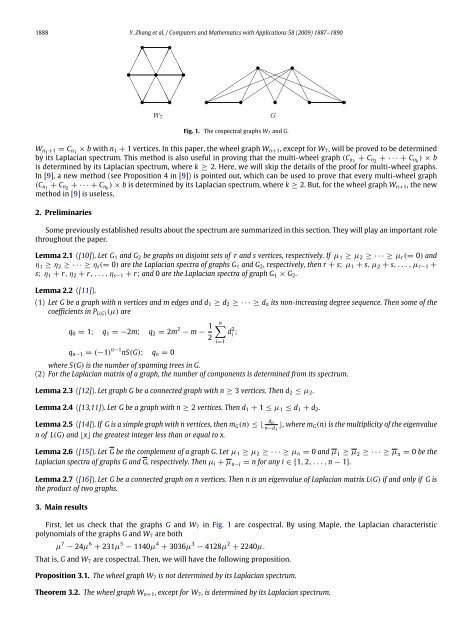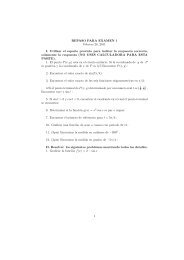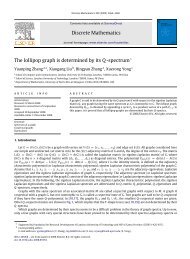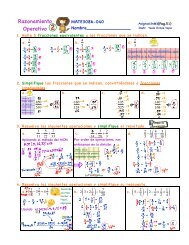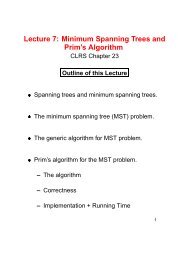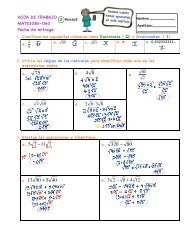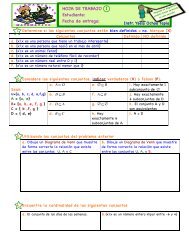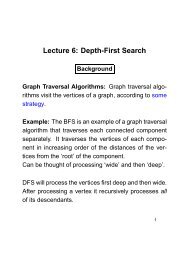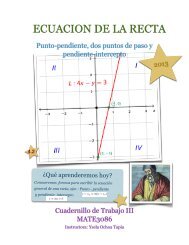Which wheel graphs are determined by their Laplacian ... - UPRM
Which wheel graphs are determined by their Laplacian ... - UPRM
Which wheel graphs are determined by their Laplacian ... - UPRM
You also want an ePaper? Increase the reach of your titles
YUMPU automatically turns print PDFs into web optimized ePapers that Google loves.
1888 Y. Zhang et al. / Computers and Mathematics with Applications 58 (2009) 1887–1890<br />
Fig. 1. The cospectral <strong>graphs</strong> W 7 and G.<br />
W n1 +1 = C n1 × b with n 1 + 1 vertices. In this paper, the <strong>wheel</strong> graph W n+1 , except for W 7 , will be proved to be <strong>determined</strong><br />
<strong>by</strong> its <strong>Laplacian</strong> spectrum. This method is also useful in proving that the multi-<strong>wheel</strong> graph (C n1 + C n2 + · · · + C nk ) × b<br />
is <strong>determined</strong> <strong>by</strong> its <strong>Laplacian</strong> spectrum, where k ≥ 2. Here, we will skip the details of the proof for multi-<strong>wheel</strong> <strong>graphs</strong>.<br />
In [9], a new method (see Proposition 4 in [9]) is pointed out, which can be used to prove that every multi-<strong>wheel</strong> graph<br />
(C n1 + C n2 + · · · + C nk ) × b is <strong>determined</strong> <strong>by</strong> its <strong>Laplacian</strong> spectrum, where k ≥ 2. But, for the <strong>wheel</strong> graph W n+1 , the new<br />
method in [9] is useless.<br />
2. Preliminaries<br />
Some previously established results about the spectrum <strong>are</strong> summarized in this section. They will play an important role<br />
throughout the paper.<br />
Lemma 2.1 ([10]). Let G 1 and G 2 be <strong>graphs</strong> on disjoint sets of r and s vertices, respectively. If µ 1 ≥ µ 2 ≥ · · · ≥ µ r (= 0) and<br />
η 1 ≥ η 2 ≥ · · · ≥ η s (= 0) <strong>are</strong> the <strong>Laplacian</strong> spectra of <strong>graphs</strong> G 1 and G 2 , respectively, then r + s; µ 1 + s, µ 2 + s, . . . , µ r−1 +<br />
s; η 1 + r, η 2 + r, . . . , η s−1 + r; and 0 <strong>are</strong> the <strong>Laplacian</strong> spectra of graph G 1 × G 2 .<br />
Lemma 2.2 ([11]).<br />
(1) Let G be a graph with n vertices and m edges and d 1 ≥ d 2 ≥ · · · ≥ d n its non-increasing degree sequence. Then some of the<br />
coefficients in P L(G) (µ) <strong>are</strong><br />
q 0 = 1; q 1 = −2m; q 2 = 2m 2 − m − 1 n∑<br />
d 2 i<br />
2<br />
;<br />
q n−1 = (−1) n−1 nS(G); q n = 0<br />
where S(G) is the number of spanning trees in G.<br />
(2) For the <strong>Laplacian</strong> matrix of a graph, the number of components is <strong>determined</strong> from its spectrum.<br />
Lemma 2.3 ([12]). Let graph G be a connected graph with n ≥ 3 vertices. Then d 2 ≤ µ 2 .<br />
Lemma 2.4 ([13,11]). Let G be a graph with n ≥ 2 vertices. Then d 1 + 1 ≤ µ 1 ≤ d 1 + d 2 .<br />
i=1<br />
Lemma 2.5 ([14]). If G is a simple graph with n vertices, then m G (n) ≤ ⌊ d n<br />
n−d 1<br />
⌋, where m G (n) is the multiplicity of the eigenvalue<br />
n of L(G) and ⌊x⌋ the greatest integer less than or equal to x.<br />
Lemma 2.6 ([15]). Let G be the complement of a graph G. Let µ 1 ≥ µ 2 ≥ · · · ≥ µ n = 0 and µ 1 ≥ µ 2 ≥ · · · ≥ µ n = 0 be the<br />
<strong>Laplacian</strong> spectra of <strong>graphs</strong> G and G, respectively. Then µ i + µ n−i = n for any i ∈ {1, 2, . . . , n − 1}.<br />
Lemma 2.7 ([16]). Let G be a connected graph on n vertices. Then n is an eigenvalue of <strong>Laplacian</strong> matrix L(G) if and only if G is<br />
the product of two <strong>graphs</strong>.<br />
3. Main results<br />
First, let us check that the <strong>graphs</strong> G and W 7 in Fig. 1 <strong>are</strong> cospectral. By using Maple, the <strong>Laplacian</strong> characteristic<br />
polynomials of the <strong>graphs</strong> G and W 7 <strong>are</strong> both<br />
µ 7 − 24µ 6 + 231µ 5 − 1140µ 4 + 3036µ 3 − 4128µ 2 + 2240µ.<br />
That is, G and W 7 <strong>are</strong> cospectral. Then, we will have the following proposition.<br />
Proposition 3.1. The <strong>wheel</strong> graph W 7 is not <strong>determined</strong> <strong>by</strong> its <strong>Laplacian</strong> spectrum.<br />
Theorem 3.2. The <strong>wheel</strong> graph W n+1 , except for W 7 , is <strong>determined</strong> <strong>by</strong> its <strong>Laplacian</strong> spectrum.


